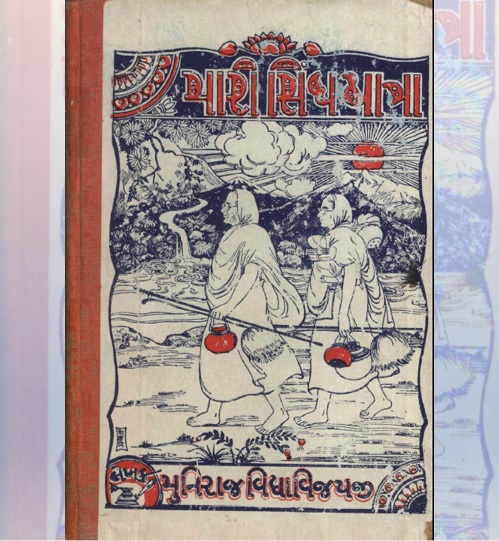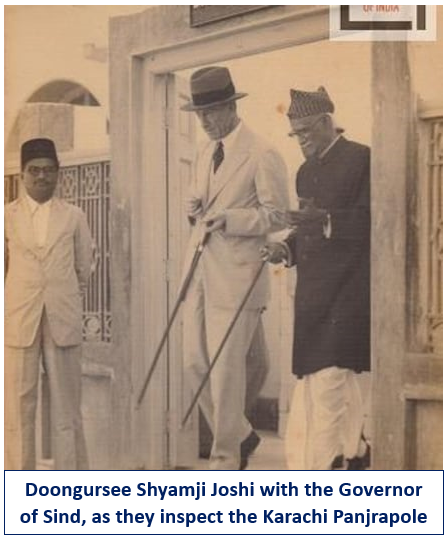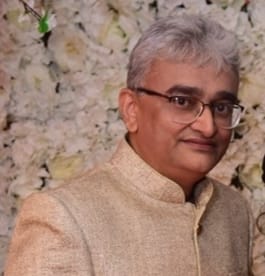
Population of Jains in Karachi was 3500. They include Gujarati, Kathiyawadi, Kutchi and Marwadi Jains
[Editor’s Note: This is Part 32 (The Stature of Jains – Part– 1) of a series of articles based on a pre-partition book named “મારી સિંધ યાત્રા” (“منهنجي سنڌ جو سفر”) in Gujarati authored by a scholarly Jain sadhu Shri Vidyavijayji, narrating his experiences of Journey and his Stay in Karachi for about 2 and a half years between 1937 and 1939. It would be advisable to click on the Introductory Article and read it to better understand the series. – Nasir Aijaz, Editor Sindh Courier]
Vimal Shah, Mumbai
The Stature of Jains
Like how the stature of Karachi is high among prime cities of Hindustan, ‘Karachi Jain Sangh’ can also be considered one among the prime ‘Jain Sangh’ of Hindustan. Like many other cities, the population of Jains migrated from various regions to this place is about 3,500. That includes Gujarati, Kathiyawadi, Kutchi and Marwadi – these four categories known by their origins.
[Note by Vimal Shah: ‘Sangh’ means a Congregation]
It is already said earlier that Gujaratis arrived here about a hundred and twenty-five years ago. Then it is also necessary to know when Jains arrived.
When did Jains Arrive?
As such I have already covered in the sections named ‘Ancient Sindh – from Jain Perspective’ that there were thousands of Jains in Sindh, hundreds of Jain Temples were there, and they were highly prosperous. It is said that at a time there was a large population of Jains in Nagar Thatta. Today there’s not even a single Jain family there, but there’s a ‘Bhavda’ Mohalla there named after Jains, who were known as ‘Bhavda’. Even today Jains are referred as ‘Bhavda’ in Punjab. The Jains in Hala are migrated over three hundred years ago from Jaisalmer, Pali, etc. and settled there. There were many Jains in Umarkot as well but now there are only about ten to twelve families.
[Note by Vimal Shah: The Jains are known as ‘Bhavda’ / ‘Bhavra’ / ‘Bhabda’ / ‘Bhabra’ in Punjab and Sindh]
Our purpose here is with respect to Karachi. It is important to know when Jains came to Karachi.
There’s a ‘Bhavda’ Mohalla in Thatta named after Jains, who were known as ‘Bhavda’. Even today Jains are referred as ‘Bhavda’ in Punjab
After a lot of investigation, we found that Jains came to Karachi ever since the Britishers came here. It is said that Sheth Leelachand Chaiwala of Patan was the first to come here along with Britishers. That period is around the year 1840, which is about a hundred years ago.
After that around the year 1851, Kutchi brothers from the Kheta region in Kutch; Kala Gala, Bawa Amarchand, Sheth Panachand Mavji from Sayla, Sheth Jamnadas Multani from Ahmedabad, and Sheth Umerchand Motichand from Uvarsad came here. During the same period started arrival of marwadi Sheth Navalmalji Gumanmalji, and others from Pali in Marwad. Likewise, Sthanakwasi Sheth Damar Neemji, Trikam Kalu, and Pragji Panachand from the Kutchhi community had also arrived. It is said that all these were accomplished entrepreneur businessmen.
Jains came to Karachi ever since the Britishers came here
Name of Sheth Premabhai Hemabhai of Ahmedabad is also added to this list. It is said that this Nagarsheth of Ahmedabad owns thousands of yards of land in Karachi, and he is making efforts to get the possession of it.
[Note by Vimal Shah: Nagarsheth Premabhai Hemabhai (1815-1887) was a prominent businessman. He was the 6th Nagarsheth of Ahmedabad city, in tradition of Nagarsheth, from Shantidas Zaveri family. During the rebellion of 1857, he ran a private Angadia (Courier) service. He was entitled “Rav Saheb” in 1877 by Government for his devotion to the government. He was given the honorary membership of Mumbai Govt. Legislative Assembly. He was the president of Gujarat Vernacular Society (now Gujarat Vidhyasabha) for which he had donated. He had also donated for Premabhai Hall and Prem Darwaja. He had donated Rs.20,000 for the Old Civil Hospital, Ahmedabad.]
 From the gentlemen listed above, Shri Khushalbhai Vastachand and his brother Sheth Gangjibhai Tejpal are surviving from the families of Kutchi Brothers from Kheta region. Sheth Khetsi Bhai, Sheth Bhoodarji Bhai, Bhai Chaturbhuj, and Bhai Shantilal are surviving from the family of Sheth Kala Gala. There’s no information about anyone surviving from the family of Bawa Amarchand. Sheth Khimchand J Panachand is surviving from the family of Sheth Panachand Mavji. Among the Marwadi families, Sheth Hakamchandji, son of Bhagwandas from the family of Sheth Navmalji lives in Hala these days. Shivlal Bhai is surviving from the family of Sheth Damar Nimji. And Bhai Maneklal, son of Dhanji Bhai is surviving from the family of Trikam Kalu.
From the gentlemen listed above, Shri Khushalbhai Vastachand and his brother Sheth Gangjibhai Tejpal are surviving from the families of Kutchi Brothers from Kheta region. Sheth Khetsi Bhai, Sheth Bhoodarji Bhai, Bhai Chaturbhuj, and Bhai Shantilal are surviving from the family of Sheth Kala Gala. There’s no information about anyone surviving from the family of Bawa Amarchand. Sheth Khimchand J Panachand is surviving from the family of Sheth Panachand Mavji. Among the Marwadi families, Sheth Hakamchandji, son of Bhagwandas from the family of Sheth Navmalji lives in Hala these days. Shivlal Bhai is surviving from the family of Sheth Damar Nimji. And Bhai Maneklal, son of Dhanji Bhai is surviving from the family of Trikam Kalu.
[Note by Vimal Shah: Panjrapole is an animal shelter originally started by Jains centuries ago. All kinds of animals in distress or abandoned ones are rescued, treated, and fed here.]
Panjrapole
It is said that Gujaratis used to live in Soldier Bazar. Sheth Kala Gala and Marwadis used to live in Saddar, whereas Kutchi brothers used to live in Ranchore Line. One more fact we could find is a Panjrapole was established on the Bunder Road opposite High School, with the appreciable efforts of Bawa Amarchand, Sheth Kala Gala, and Sheth Jamnadas living in Sadar. This Panjrapole was sustained only by the businessmen living in Soldier Bazar and Saddar. Sheth Kala Gala handed over the Panjrapole after a few years to Sheth Aaskaran Khengar, Sheth Manekchand Pitambar, and Sheth Ramdas Morarji. By that time the Panjrapole had progressed a lot.
The credit of establishing popular Panjrapoles of Karach goes to the Jain community
Similarly, Jains had a prime role to play along with the Vaishnav community in establishing a Panjrapole in the Lyari Quarter along the river.
According to these facts, the credit of establishing popular Panjrapoles of Karach goes to the Jain community. (Continues- Read Part-33 on Sunday September 3, 2023)
Click here for Part-I, Part-II, Part-III, Part-IV, Part-V , Part-VI , Part-VII , Part-VIII , Part-IX, Part-X, Part-XI, Part-XII, Part-XIII , Part-XIV, Part-XV, Part-XVI , Part-XVII, Part-XVIII , Part-XIX, Part-XX, Part-XXI, Part-XXII , Part-XXIII , Part-XXIV, Part-XXV , Part-XXVI, Part-XXVII, Part-XXVIII, Part-XXIX , Part-XXX, Part-XXXI
________________
About the contributor of the series of Articles based on the book
 Vimal Shah is a follower of Jainism by birth and is based in Mumbai, India. He is a Computer Engineer and holds a Diploma in Jainology from Mumbai University. He has an immense interest in reading, writing, studying, and teaching Jain Philosophical subjects. He conducts classroom as well as online sessions on Jain Philosophical courses. He continues to study various subjects and remains a student of Jain Philosophy. He has significantly contributed to the Translation Project of the ‘Compendium of Jainism’ from English to Gujarati – an initiative of the JAINA India Foundation. He is also associated with a Project for the translation of Jain Aagams (Scriptures) from Gujarati to English. He has a special interest in the history and preservation of the Jain Heritage in Pakistan. He was part of a Delegation of the Jain Heritage Foundation, New Delhi that visited various Jain Heritage Sites in Pakistan in May-2023.
Vimal Shah is a follower of Jainism by birth and is based in Mumbai, India. He is a Computer Engineer and holds a Diploma in Jainology from Mumbai University. He has an immense interest in reading, writing, studying, and teaching Jain Philosophical subjects. He conducts classroom as well as online sessions on Jain Philosophical courses. He continues to study various subjects and remains a student of Jain Philosophy. He has significantly contributed to the Translation Project of the ‘Compendium of Jainism’ from English to Gujarati – an initiative of the JAINA India Foundation. He is also associated with a Project for the translation of Jain Aagams (Scriptures) from Gujarati to English. He has a special interest in the history and preservation of the Jain Heritage in Pakistan. He was part of a Delegation of the Jain Heritage Foundation, New Delhi that visited various Jain Heritage Sites in Pakistan in May-2023.